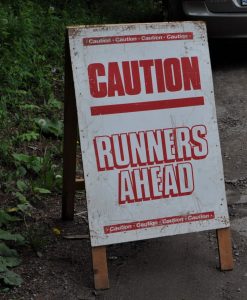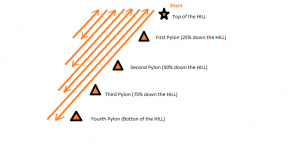What do these Run Workout titles mean anyway?
Easy Runs: These are recovery runs and their goal is to remove lactic acid, improve tissue recovery and prepare your body for your next run. Your HR should be the lowest of all of your runs. (HR: Zone 2 – 60-70% of your Max Effort)
Long Runs: These are the most important runs of this program and are never to be done at race pace. They should be used to test carbo-loading, race day hydration and nutrition techniques. When you feel that your fitness has improved after about 6 weeks of training in the program, you should expect to run your long runs within 20-30 seconds per kilometre of your Race Pace(HR Zone 3a – 70-80% of your Max Effort)
Tempo Runs: This run is designed to increase your high-speed endurance, and is defined as “the effort and speed that you can maintain maximally for 1 hour”. If you can string together more than 3 words while running, your effort should be increased. Your HR should be maintained evenly throughout the run. Most Tempo runs become like races – as you push yourself into a zone of being comfortably uncomfortable – it has to feel tough and mentally challenging to hold your pace. (HR Zone 4a – 85-90% of your Max Effort)
Watch Free Runs: These runs should be an hour or less in time, and should be done by feel. No music, No watch, No Garmin, No fuel. Just run.
Speed, Intervals, Track: These runs should be at 90-95% effort and your repeat times should be the same +/- 5 seconds. Recovery time should be 1:30 or until your HR drops back down to 100bpm. (HR Zone 4b – 90-95% of your Max Effort)
Hill Repeats (Hills): These repeats are done to build leg strength for running on all different types of terrain. The hills we will use are on Speers Road and Cross Ave. These repeats will demonstrate your absolute maximum heart rate as you reach the summit of each climb. The downhill return should be effortless in order to aid recovery. (HR Zone 4b – 5 – 90-100% of your Max Effort)
Trills: Same as above except we run them on Trail-HILLS.
Pylons: These Hill repeats are also done on the hills of Speers Road and Cross Ave. The difference between Hill Repeats and Pylons is considerable; in how you feel doing them, the goal of the repeats, and your efforts on the roads.
We divide the long hill into 4 sections.
The distance between pylons is 2 light posts.
Top of the Hill
* 1st Pylon
* 2nd Pylon
* 3rd Pylon
* 4th Pylon Bottom of the Hill
We run a 2K warmup then run down to the bottom of the Hill (4th Pylon). We start our Hard effort up from the bottom to the top. Then we run in recovery effort back down to the 3rd pylon. Run hard back to the top. Then back down to the 2nd Pylon. Hard run back to the top. Recovery effort down to the 1st Pylon, then hard back to the top. That equals 1 set of Pylons. It equates to 2.5 hill repeats. Each set should be run continuously. Rest and refuelling can happen at the top AFTER a full set is complete.
Fartleks: A Swedish word for a run that contains many changes in effort throughout its duration. (HR Zone 4b)
Hilly Run: When we have shifted to speed work in the latter part of the program, we often add a Hilly Run on a Tuesday that will challenge your leg strength. This run should be done in a continuous loop that contains 3-6 hills.
Hard Efforts: Within a long run, these Hard Efforts should be run like a 1 minute segment of a 10K Tempo Run. (Zone 4a) Please run them spaced out within the run with a 5K warm-up before the first one, and leave the last 4K for cool down.
‘Special’ Runs: These are yet to be revealed, and will reflect the need to alter your speeds or the terrain within your long runs. I can’t wait to share what we have in store for you. (HR Zone All Over the place!)
Pyramid Intervals: These runs will test your fitness and promote proper recovery and increased leg turnover speed. After a 2K warm up run, the intervals will start at 1 minute of HARD effort followed by an equal amount of recovery/EASY running. The pyramid will climb up to 4 minutes or 5 minutes based on your schedule and race day goals. (Peaks at Zone 4a-4b during HARD efforts)
1-2 Punch: These are perceived effort, timed intervals with alternating Hard and Recovery/Easy Efforts. They have very little to do with distance covered and are more about the effort you give during the interval. After a 2K warm-up, you run 1 minute HARD, followed immediately by 2 minutes EASY, followed immediately by 2 Minutes HARD, then 1 minute EASY. This counts as 1 time through, and the workout may call for 4-6 repeats. The repeats are consecutive and are therefore run without stopping in between. In a group setting, the EASY efforts provide an opportunity for the groups to reconnect after the natural separation that happens when you have variances in speed amongst the runners.
3,4,5 Kick: For endurance races, we aim to get faster, push our lactate threshold higher and to gain personal intrinsic knowledge about pacing. This workout helps us to make progress in all three of these key areas. After a 2-3K warmup, your first effort will be 3 minutes of Hard running (5K-10K Race Pace) followed by 3 minutes of recovery – this should be an active recovery so keep moving. If you are running in a group, you can use this recovery interval as an opportunity to re-group. The next Interval is 4 minutes Hard, 4 minutes recovery, then 5 and 5. This may be repeated as a set after that 5 minutes of recovery – be sure to look closely at your schedule. As the Intervals grow in length of time, the pace should slow a bit, but never slower than half marathon race pace for the 5 minutes of Hard running. (HR Zone 4a-4b during HARD efforts).
HIIT Runs: These runs are designed to increase your speed without exposing you to the rigours of large numbers of high intensity miles, which may contribute to overuse injuries. The Hard efforts are SHORT, but should be HARD. The Easy efforts are LONG, but should be EASY! This is very important.
Race Pace: Exactly as they sound, runs should be done at the same pace as you plan to race. (HR Zone 3a – 3b)
Accelerations: On the days leading up to race day, accelerations from 0 metres-80/100 metres ( The last 4-5 steps of which are run at top speed) are a great way to remind your legs of their ability to run fast. This is a common technique used within a 3K easy run in order to “break” the taper where you have only been running slower miles. (HR Zone 4b at the end of 80 metres)
Build Runs: This is a segment of a run or an entire run where you start very slow but end very fast as you gradually pick up the pace along the way. It is often broken up by distance but can also be done using time intervals.
IN and Outs: This is a Track based workout where (after a healthy warmup of 2-3K) you run loops of the track in a specific way: Run HARD on the straight sections and EASY on the curves. This is a continuous run once you’re on the track, but if you’re going to place fuel anywhere, put it on the curve.
The REID: Named after Olympian Reid Coolsaet, this is one of his favourite workouts to do leading up to a race. 3K warm-up then 30 Minutes of HARD Hill Repeats followed by a 3K cool-down. Awesome.
Cut Down Tempo Runs: This is a way to break up your Tempo effort and make your gains more dynamic for racing. After warming up, you start with the longest Interval and work your way down to 1 minute of hard running. Let’s talk about pacing; the longest interval (often around 6 minutes) should be run at Half Marathon Race Pace, each interval that is shorter should get a little faster. The last 1 minute interval should be at 5K Race Pace. Note: this is still a Tempo run at heart, so your recovery intervals are only 1 minute long. There is 3 minutes of recovery in between Cut Down sets if you are doing multiples.
Progression Runs: These runs are similar to ‘THIRDS’ runs, only more specific to your Race Day goals. We will use an 18K progression run as an example here: First 6K @ EZ Pace, 2nd 6K building up to your target race pace, last 6K @ Race Pace.
Float Runs: All Runners know what it feels like to ‘Float’ while running – it’s when you run at a pace that feels like you could do it forever, your breathing is in sync with your legs and your heart and your miles feel easy. Of course this pace changes as your fitness improves, so don’t be limited by the pace your watch suggests, it also changes with your fitness as the season goes on so the actual pace is not static. It can change with temperature, with terrain, with incline or decline, with illness, with caffeine, with dehydration. It can even change when we use music or when we are lost in thought. It is another way of describing a run that we should enjoy and always end with a smile. Float On. (HR Zone 2-3)
SPEED UP: This workout is 2x the same distance, where you start out slow, and progressively get faster throughout each set. The second repeat would start out slow again, building to strong at the end. There can be a minute or 2 recovery in between, but you can also just slowly build into the second repeat.
BQ/PB: This denotes the ‘Extra’ distance and workouts that I recommend you run in case you want to BQ (Qualify for Boston) or run a PB (Personal Best) at your goal distance.
10-20-30: This workout requires significant warmup, and the numbers represent the time in seconds at each effort. The first 30 seconds of the drill is very light jogging, NO WALKING, just jogging. The second 20 seconds should be a medium paced run effort, perhaps marathon race pace. The last 10 seconds should be at 100% effort – It’s a SPRINT! This equals one minute of running, and it rolls into the next minute right away. The schedule will suggest a total number of minutes for this drill, and those minutes are done consecutively.


